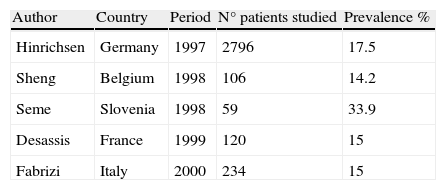Hepatitis G virus (HGV) or GB-virus type C (GBV-C) is a RNA-single stranded blood-borne virus and, like hepatitis C virus, belongs to the Flaviviridae family. Infection with HGV is common in the world. Little is known of the natural history of HGV infection in the general population. Blood transfusions are the main risk factor for HGV transmission, but unapparent parenteral routes are also known (sexual, perinatal or intrafamily routes). HGV infection has been found in 1–3% of volunteer blood donors, while higher prevalence have been recorded in patients with a history of parenteral exposure, i.e. intravenous drug users, multitransfused patients and in subjects with different forms of chronic hepatitis. Haemodialysis patients are at high risk of acquiring parenterally transmitted viral infections. For epidemiological reasons HGV infection is of interest in haemodialysis patients. Up to 2000 year in European countries the serological surveys concerning HGV infection in haemodialysis patients have shown a considerable seroprevalence1–5 (Table 1). Instead there are few recent studies about this topic. We studied the seroprevalence of HGV infection in a cohort of subjects on chronic haemodialysis treatment. During 2009 we screened 84 patients on maintenance haemodialysis: 2 were African, 2 Asiatic and the other of Caucasian ethnicity; they received a thrice/weekly haemodialysis schedule. All patients were tested for HBsAg, HBsAb, HBcAb and HCVAb. For HGV the anti-E2 antibody was tested by ELISA (Diagnostic Automation, Inc.). We performed liver function tests and other common laboratory investigations. All patients were anti-E2 HGV-negative. We detected: 1 subject HIV-positive (already known); 2 patients (2.3%) HBsAg-positive and 47 (55%) HBsAb and/or HBcAb-positive; 9 patients (10.7%) HCVAb-positive and 7 (8.3%) HCV-RNA positive. Liver function tests, platelets count and coagulation parameters were unremarkable. Nowadays HGV is known to infect humans, but is not known to cause human disease. There is debate about the appropriateness of the concept “viral hepatitis G” compared with the assessed lymphotrophism; in haemodialysis setting the trend of HGV infection ‘s prevalence is probably on the decrease like to HCV infection. The interest of HGV infections is likely to be associated with the similarity with HCV because of shared modes of transmission.
We declare that the results presented in this paper have not been published previously in whole or part, except in abstract form.




